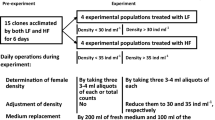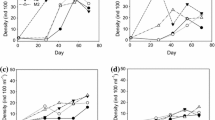Abstract
Populations of generalist grazers often contain genotypes with “powerful” and “efficient” strategies. Powerful genotypes grow rapidly on rich-quality resources, but slowly on poorer-quality ones, while efficient genotypes grow relatively better on poorer resources but cannot exploit richer resources as well. Via a “power–efficiency” trade-off, variation in resource quality could maintain genetic diversity. To evaluate this mechanism, we sampled six populations of the freshwater cladoceran Daphnia pulicaria. In persisting (year-round) populations, Daphnia consume resources that vary in quality, whereas in non-persisting (spring-only) populations, Daphnia primarily encounter rich-quality resources. We hypothesized that non-persisting populations harbor no efficient clones (hence should show lower growth on poor-quality resources). Although individuals from non-persisting populations remained smaller than individuals from persisting populations, no evidence arose for a trade-off between powerful and efficient strategies. In fact, growth rates on the two diets were positively correlated (instead of negatively, as predicted). Furthermore, in the persisting populations, we predicted that clonal selection from spring to summer should shift the distribution of genotypes from powerful (specialists on richer spring resources) to efficient (poorer, summer resources). Genetic composition of populations shifted from spring to summer, but not toward more efficient genotypes. Therefore, in these lakes, maintenance of variation among genotypes must stem from more complicated factors than population persistence patterns or seasonal shifts in resource quality alone.




Similar content being viewed by others
References
Allen MR, Thum RA, Cáceres CE (2010) Does local adaptation to resources explain genetic differentiation among Daphnia populations? Mol Ecol 19:3076–3087
Allen MR, Thum RA, VanDyke JN, Cáceres CE (2012) Trait sorting in Daphnia colonizing man-made lakes. Freshwater Biol 59:1813–1822
Araújo MS, Bolnick DI, Layman CA (2011) The ecological causes of individual specialization. Ecol Lett 14:948–958
Becker C, Boersma M (2003) Resource quality effects on life histories of Daphnia. Limnol Oceanogr 48:700–706
Bell ATC, Murray DL, Prater C, Frost PC (2019) Fear and food: Effects of predator-driven chemical cues and stoichiometric food quality on Daphnia. Limnol Oceanogr 64:1706–1715
Bertram CR, Pinkowski M, Hall SR, Duffy MA, Cáceres CE (2013) Trait-mediated indirect effects, predators, and disease: Test of a size-based model. Oecologia 173:1023–1032
Bolnick DI, Svanbäck R, Fordyce JA, Yang LH, Davis JM, Hulsey CD, Forister ML (2003) The ecology of individuals: incidence and implications of individual specialization. Am Nat 161:1–28
Bolnick DI, Amarasekare P, Araújo MS, Bürger R, Levine JM, Novak M, Rudolf VHW, Schreiber SJ, Urban MC, Vasseur DA (2011) Why intraspecific trait variation matters in community ecology. Trends Ecol Evol 26:183–192
Boon AK, Réale D, Boutin S (2007) The interaction between personality, offspring fitness and food abundance in North American red squirrels. Ecol Lett 10:1094–1104
Brooks JL, Dodson SI (1965) Predation, body size, and composition of plankton. Science 150:28–35
Brzeziński T, von Elert E (2007) Biochemical food quality effects on a Daphnia hybrid complex. Limnol Oceanogr 52:2350–2357
Brzeziński T, Dawidowicz P, von Elert E (2010) The role of food quality in clonal succession in Daphnia: an experimental text. Oecologia 164:379–388
Cáceres CE, Tessier AJ (2004) Incidence of diapause varies among populations of Daphnia pulicaria. Oecologia 141:425–431
Cáceres CE, Hartway C, Paczolt K (2009) Inbreeding depression varies with investment in sex in a facultative parthenogen. Evolution 63:2474–2480
Chopelet J, Blier PU, Dufresne F (2008) Plasticity of growth rate and metabolism in Daphnia magna populations from different thermal habitats. J Exp Zool A Ecol Genet Physiol 309:553–562
Civitello DJ, Cohen J, Fatima H, Halstead NT, Liriano J, McMahon TA, Ortega CN, Sauer EL, Sehgal T, Young S, Rohr JR (2015) Biodiversity inhibits parasites: broad evidence for the dilution effect. Proc Natl Acad Sci 112:8667–8671
Colbourne J, Robinson B, Bogart K, Lynch M (2004) Five hundred and twenty-eight microsatellite markers for ecological genomic investigations using Daphnia. Mol Ecol Notes 4:485–490
Cristescu MEA, Colbourne JK, Radivojac J, Lynch M (2006) A microsatellite-based genetic linkage map of the waterflea, Daphnia pulex: On the prospect of crustacean genomics. Genomics 88:415–430
DeMott WR, Tessier AJ (2002) Stoichiometric constraints vs. algal defenses: testing mechanisms of zooplankton food limitation. Ecology 83:3426–3433
DeMott WR, McKinney EN, Tessier AJ (2010) Ontogeny of digestion in Daphnia: implications for the effectiveness of algal defenses. Ecology 91:540–548
De Stasio BT, Rudstam LG, Haning A, Soranno P, Allen YC (1995) An in situ test of the effects of food quality on Daphnia population growth. Hydrobiologia 307:221–230
Duffy MA, Brassil CE, Hall SR, Tessier AJ, Cáceres CE, Conner JK (2008) Parasite-mediated disruptive selection in a natural Daphnia population. BMC Evol Biol 8:80–89
Duffy MA, Cáceres CE, Hall SR, Tessier AJ, Ives AR (2010) Temporal, spatial, and between-host comparisons of patterns of parasitism in lake zooplankton. Ecology 91:3322–3331
Duffy MA, Housley JM, Penczykowski RM, Cáceres CE, Hall SR (2011) Unhealthy herds: indirect effects of predators enhance two drivers of disease spread. Funct Ecol 25:945–953
Duffy MA, Housley Ochs J, Penczykowski RM, Civitello DJ, Klausmeier CA, Hall SR (2012) Ecological context influences epidemic size and parasite-mediated selection. Science 335:1636–1638
Edwards KF, Klausmeier CA, Litchman E (2011) Evidence for a three-way trade-off between nitrogen and phosphorus competitive abilities and cell size in phytoplankton. Ecology 92:2085–2095
Forsman A, Wennersten L (2015) Inter-individual variation promotes ecological success of populations and species: evidence from experimental and comparative studies. Ecography 39:630–648
Fridley JD, Grime JP (2010) Community- and ecosystem-level consequences of intraspecific genetic diversity in grassland microcosms of varying species diversity. Ecology 91:2272–2283
Giebelhausen B, Lampert W (2001) Temperature reaction norms of Daphnia magna: the effect of food concentration. Freshwater Biol 46:281–289
Hairston NG, Lampert W, Cáceres CE, Holtmeier CL, Weider LJ, Gaedke U, Fischer JM, Fox JA, Post DM (1999) Rapid evolution revealed by dormant eggs. Nature 401:446
Hairston NG, Holtmeier CL, Lampert W, Weider LJ, Post DM, Fischer JM, Cáceres CE, Fox JA, Gaedke U (2001) Natural selection for grazer resistance to toxic cyanobacteria: evolution of phenotypic plasticity? Evolution 55:2203–2214
Hall SR, Sivars-Becker L, Becker C, Duffy MA, Tessier AJ, Cáceres CE (2007) Eating yourself sick: transmission of disease as a function of foraging ecology. Ecol Lett 10:207–218
Hall SR, Becker CR, Duffy MA, Cáceres CE (2012) A power–efficiency trade-off in resource use alters epidemiological relationships. Ecology 93:645–656
Hart RC, Bycheck EA (2011) Body size in freshwater planktonic crustaceans: an overview of extrinsic determinants and modifying influences of biotic interactions. Hydrobiologia 668:61–108
Holmes CJ, Pantel JH, Schulz KL, Cáceres CE (2016) Initial genetic diversity enhances population establishment and alters genetic structuring of a newly established Daphnia metapopulation. Mol Ecol 25:3299–3308
Hu SS, Tessier AJ (1995) Seasonal succession and the strength of intra- and interspecific competition in a Daphnia assemblage. Ecology 76:2278–2294
Jeyasingh PD, Weider LJ, Sterner RW (2009) Genetically-based trade-offs in response to stoichiometric food quality influences competition in a keystone aquatic herbivore. Ecol Lett 12:1229–1237
Johnson PTJ, Longcore JE, Stanton DE, Carnegie RB, Shields JD, Preu ER (2006a) Chytrid fungal infections of Daphnia pulicaria: development, ecology, pathology, and phylogeny of Polycaryum leave. Freshwater Biol 51:634–648
Johnson PTJ, Stanton DE, Preu ER, Forshay KJ, Carpenter SR (2006b) Dining on disease: how interactions between infection and environment affect predation risk. Ecology 87:1973–1980
Kassen R (2002) The experimental evolution of specialists, generalists, and the maintenance of diversity. J Evol Biol 15:173–190
Kingsolver JG, Hoekstra HE, Hoekstra JM, Berrigan D, Vignieri SN, Hill CE, Hoang A, Gibert P, Beerli P (2001) The strength of phenotypic selection in natural populations. Am Nat 157:245–261
Kirk KL (1997) Life-history responses to variable environments: starvation and reproduction in planktonic rotifers. Ecology 78:434–441
Kobe RK, Pacala SW, Silander JA (1995) Juvenile tree survivorship as a component of shade tolerance. Ecol App 5:517–532
Lampert W, Trubetskova I (1996) Juvenile growth rate as a measure of fitness in Daphnia. Funct Ecol 10(631):635
Lynch M, Walsh B (1998) Genetics and analysis of quantitative traits. Sinauer Associates Inc., Sunderland
Machacek J (1991) Indirect effect of plativourous fish on the growth and reproduction of Daphnia galeata. Hydrobiologia 225:193–197
Mitchell SE, Lampert W (2000) Temperature adaptation in a geographically widespread zooplankter, Daphnia magna. J Evol Biol 13:371–382
Odum HT, Pinkerton RC (1955) Time’s speed regulator: the optimum efficiency for maximum power output in physical and biological systems. Am Sci 43:331–343
Przytulska A, Bartosiewicz M, Rautio M, Dufresne F, Vincent WF (2015) Climate effects on high latitude Daphnia via food quality and thresholds. PLoS ONE 10(5):e0126231. https://doi.org/10.1371/journal.pone.0126231
R Core Team (2013) R: a language and environment for statistical computing. R Foundation for Statistical Computing, Vienna, Austria. http://www.R-project.org/
Raubenheimer D, Simpson SJ (1996) Meeting nutrient requirements: the roles of power and efficiency. Entomol Exp Appl 80:65–68
Ravet JL, Brett MT (2006) Phytoplankton essential fatty acids and phosphorus content constraints on Daphnia somatic growth and reproduction. Limnol Oceanogr 51:2438–2452
Reznick D, Nunney L, Tessier AJ (2000) Big houses, big cars, superfleas and the costs of reproduction. Trends Ecol Evol 15:421–425
Sommer U, Gliwicz ZM, Lampert W, Duncan A (1986) The PEG-model of seasonal succession of planktonic events in fresh waters. Arch Hydrobiol 106:433–471
Sommer U, Adrian R, De Senerpont DL, Elser JJ, Gaedke U, Ibelings B, Jeppesen E, Lüring M, Molinero JC, Mooij WM, van Donk E, Winder M (2012) Beyond the Plankton Ecology Group (PEG) model: Mechanisms driving plankton succession. Annu Rev Ecol Evol Syst 43:429–448
Sterner RW, Elser JJ (2002) Ecological Stoichiometry: The biology of elements from molecules to the biosphere. Princeton University Press, PrincetonJ
Tessier AJ, Consolatti NL (1991) Resource quantity and offspring quality in Daphnia. Ecology 72:468–478
Tessier AJ, Goulden CE (1987) Cladoceran juvenile growth. Limnol Oceanogr 32:680–686
Tessier AJ, Woodruff P (2002) Trading off the ability to exploit rich versus poor food quality. Ecol Lett 5:685–762
Tessier AJ, Leibold MA, Tsao J (2000) A fundamental trade-off in resource exploitation by Daphnia and consequences to plankton communities. Ecology 81:826–841
Violle C, Enquist BJ, McGill BJ, Jiang L, Albert CH, Hulshof C, Jung V, Messier J (2012) The return of the variance: intraspecific variability in community ecology. Trends Ecol Evol 27:244–252
Walsh MR, Post DM (2011) Interpopulation variation in a fish predator drives evolutionary divergence in prey in lakes. Proc R Soc Lond B Biol Sci 278:2628–2637
Walsh MR, Post DM (2012) The impact of intraspecific variation in a fish predator on the evolution of phenotypic plasticity and investment in sex in Daphnia ambigua. J Evol Biol 25:80–89
Weider LJ, Makino W, Acharya K, Glenn KL, Kyle M, Urabe J, Elser JJ (2005) Genotype x environment interactions, stoichiometric food quality effects, and clonal coexistence in Daphnia pulex. Oecologia 143:537–547
Wolinska J, Spaak P (2009) The cost of being common: evidence from natural Daphnia populations. Evolution 63:1893–1901
Acknowledgements
This work was supported by the National Science Foundation (DEB 1120804, DEB 1120316, DEB 1354407, DEB 1353749) and the University of Illinois at Urbana-Champaign Department of Evolution, Ecology, and Behavior (research stipends to JWC). Data collection for this project was facilitated by members of the Cáceres lab including: Grace (Abernathy) Pixton, Sarah Duple, Ping Lee, Alissa Heisel, Chris Holmes, Sherin Mahrat, Tara Stewart, and Chris Woolridge. This manuscript has been improved by comments by Catherine Albright Crawford, Becky Fuller, Katy Heath, Chris Holmes, Zoi Rapti, Tara Stewart, Lynette Strickland, Andy Suarez, and Alan Tessier. This is contribution number 2151 of the Kellogg Biological Station.
Author information
Authors and Affiliations
Contributions
CEC, SRH, and JWC designed the study, JWC and MS collected the data, and JWC and CEC analyzed the data. All authors contributed to the writing of the manuscript.
Corresponding author
Additional information
Communicated by Ulrich Sommer.
Electronic supplementary material
Below is the link to the electronic supplementary material.
Rights and permissions
About this article
Cite this article
Crawford, J.W., Schrader, M., Hall, S.R. et al. Intraspecific variation in resource use is not explained by population persistence or seasonality. Oecologia 193, 135–142 (2020). https://doi.org/10.1007/s00442-020-04651-7
Received:
Accepted:
Published:
Issue Date:
DOI: https://doi.org/10.1007/s00442-020-04651-7




